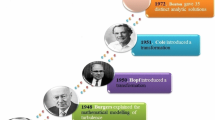Abstract
This paper is concerned with the various finite element solutions of non-linear singularly perturbed Schrödinger boundary value problems. Non-linear Schrödinger equation does not appear to have been previously studied in detail computationally and it is hope that this paper will help to provide a new idea in this direction. To linearize the nonlinear system of equations, we introduced a concept of new modified fifth order Newton type iterative method and discussed the behavior of the solution. In order to confirm our theoretical results, numerically and to demonstrate the performance of the proposed algorithm, we have considered two examples of non-linear Schrödinger’s equation involving non-linearity in homogenous and non-homogenous form.












Similar content being viewed by others
References
Floer A, Weinstein A (1986) Non-spreading wave packets for the cubic Schrödinger equation with a bounded potential. J Funct Anal 69:397–408
Oh YJ (1988) Existence of semi-classical bound states of nonlinear Schrödinger equations with potential on the class (V) a. Commun Partial Differ Equ 13:1499–1519
Oh YJ (1990) On positive multi-lump bound states nonlinear Schrödinger equations under multiple well potential. Commun Math Phys 131:223–253
Pino Md, Felmer PL (1997) Semi-classical states for nonlinear Schrödinger equations. J Funct Anal 149:245–265
Rabinowitz PH (1992) On a class of nonlinear Schrödinger equations. Z Angew Math Phys 43:270–291
Del Pino M, Felmer P, Wei J (1999) On the role of mean curvature in some singularly perturbed Neumann problems. SIAM J Math Anal 31:63–79
Gui C (1996) Multipeak solutions for a semilinear Neumann problem. Duke Math J 84:739–769
Gui C, Wei J (2000) On multiple mixed interior and boundary peak solutions for some singularly perturbed Neumann problems. Can J Math 52:522–538
Li YY (1998) On a singularly perturbed equation with Neumann boundary conditions. Commun Partial Differ Equ 23:487–545
Ni WM, Takagi I (1993) On the shape of least-energy solutions to a semi-linear Neumann problem. Duke Math J 70:247–281
Wei J (1997) On the boundary spike layer solutions of a singularly perturbed semilinear Neumann problem. J Differ Equ 134:104–133
Ni WM, Takagi I (1991) On the shape on least-energy solutions to a semi-linear Neumann problem. Commun Pure Appl Math 44:819–851
Ni WM, Takagi I (1993) Locating the peaks of least-energy solutions to a semilinear Neumann problem. Duke Math J 70:247–281
Ni WM, Wei J (1995) On the location and profile of spike-layer solutions to singularity perturbed semilinear Dirichlet problems. Commun Pure Appl Math 48:731–768
Wei J (1996) On the construction of single-peaked solutions to a singularly perturbed elliptic Dirichlet problem. J Differ Equ 129:315–333
Berestycki H, Wei J (2003) On singular perturbation problems with Robin boundary condition. Annali della Scuola Normale Superiore di Pisa, Classe di Scienze 5:199–230
Byeon J, Park J (2005) Singularly perturbed nonlinear elliptic problems on manifolds. Calc Var Partial Differ Equ 24:459–477
Wang X, Zeng B (1997) On concentration of positive bound states of nonlinear Schrödinger equations with competing potential functions. SIAM J Math Anal 28:633–655
Sulem C, Sulem PL (1999) The nonlinear Schrödinger equation. Self-focusing and wave collapse. In: Applied Mathematical Sciences, vol 139. Springer, New York
Tao T (2006) Nonlinear dispersive equations. CBMS Regional Conference Series in Mathematics. Local and global analysis, vol 106, Published for the Conference Board of the Mathematical Sciences, Washington, DC
Benci V, D’Aprile T (2002) The semiclassical limit of the nonlinear Schrödinger equation in a radial potential. J Differ Equ 184:109–138
Thukral R (2011) Eighth-order iterative methods without derivatives for solving nonlinear equations. ISRN Appl Math 2011:1–12. doi:10.5402/2011/693787
Potra FA, Ptak V (1984) Nondiscrete induction and iterative processes. Research Notes in Mathematics, vol 203. Pitnam, Boston
Brenner SC, Scott LR (2002) The mathematical theory of finite element method. Springer, New York
Ciarlet PG (2002) The finite element method for elliptic problems. North-Holland Publishing Company, Amsterdam
Mittelmann HD (1980) On the efficient solution of nonlinear finite element equations I. Numer Math 35:227–291
Feistauer M, Zenisek A (1987) Finite element solution of nonlinear elliptic problems. Numer Math 50:451–475
D’Aprile T, Pistoia A (2009) Existence, multiplicity and profile of sign-changing clustered solutions of a semiclassical nonlinear Schrödinger equation. Annales de l’Institut Henri Poincare (C) Non Linear Analysis—AN 26:1423–1451
Kumar M, Kumar P (2010) Simulation of a nonlinear Steklov eigen value problem using finite element approximation. Comput Math Model 21:109–116
Kumar M, Srivastava A, Singh AK (2012) Numerical simulation of singularly perturbed non-linear elliptic boundary value problems using finite element method. Appl Math Comput 219:226–236
Acknowledgments
The first and third author wish to express his appreciation for the financial support provided by Department of Science and Technology, New Delhi India under research grant sanction order No. SR/FTP/MS-14/2007. The authors also extend their appreciation to anonymous reviewers for their valuable suggestions to improve the quality of this paper.
Author information
Authors and Affiliations
Corresponding author
Appendix
Appendix
Matlab Code for the Solution of Singularly Perturbed Non-Linear Schrödinger equation 




Rights and permissions
About this article
Cite this article
Kumar, M., Srivastava, A. & Mishra, G. Numerical Simulation of a Non-linear Singular Perturbed Schrödinger Equation Using Finite Element Approximation. Natl. Acad. Sci. Lett. 36, 239–252 (2013). https://doi.org/10.1007/s40009-013-0125-3
Received:
Revised:
Accepted:
Published:
Issue Date:
DOI: https://doi.org/10.1007/s40009-013-0125-3




